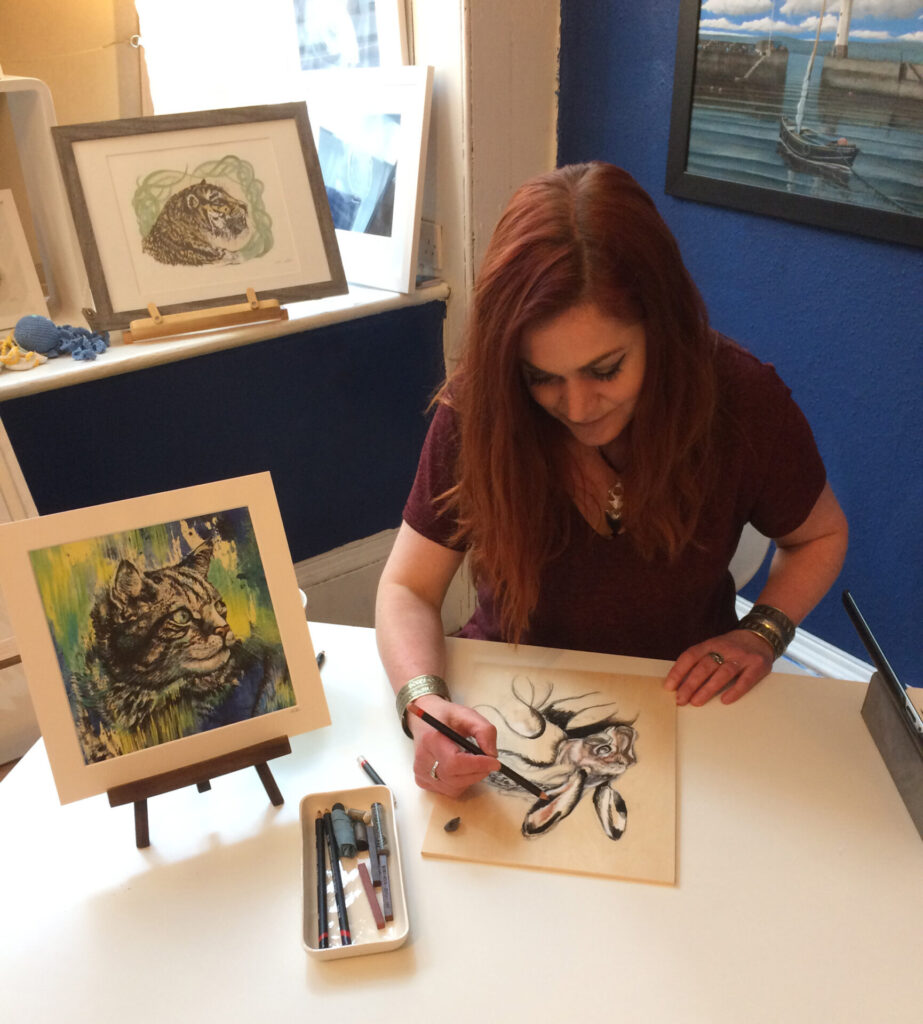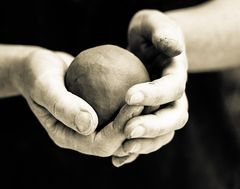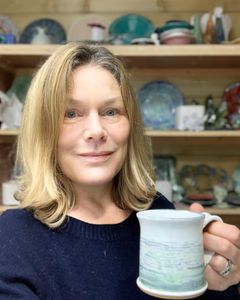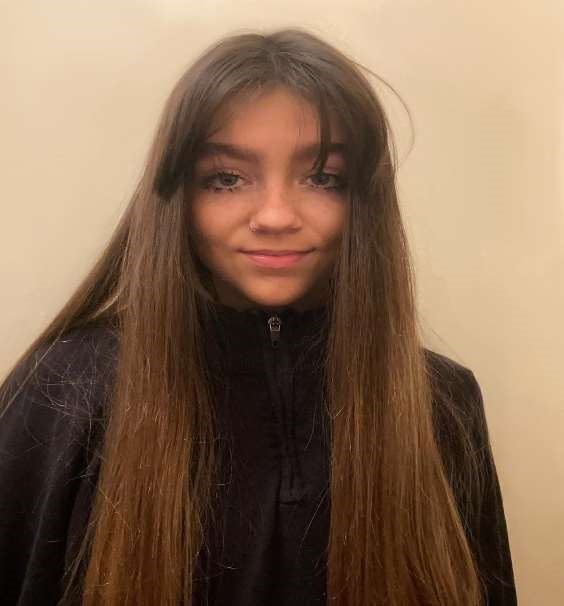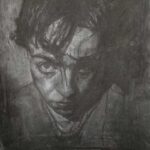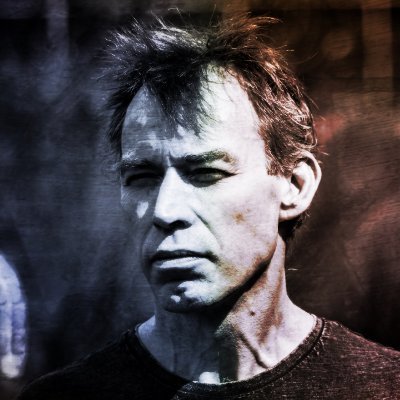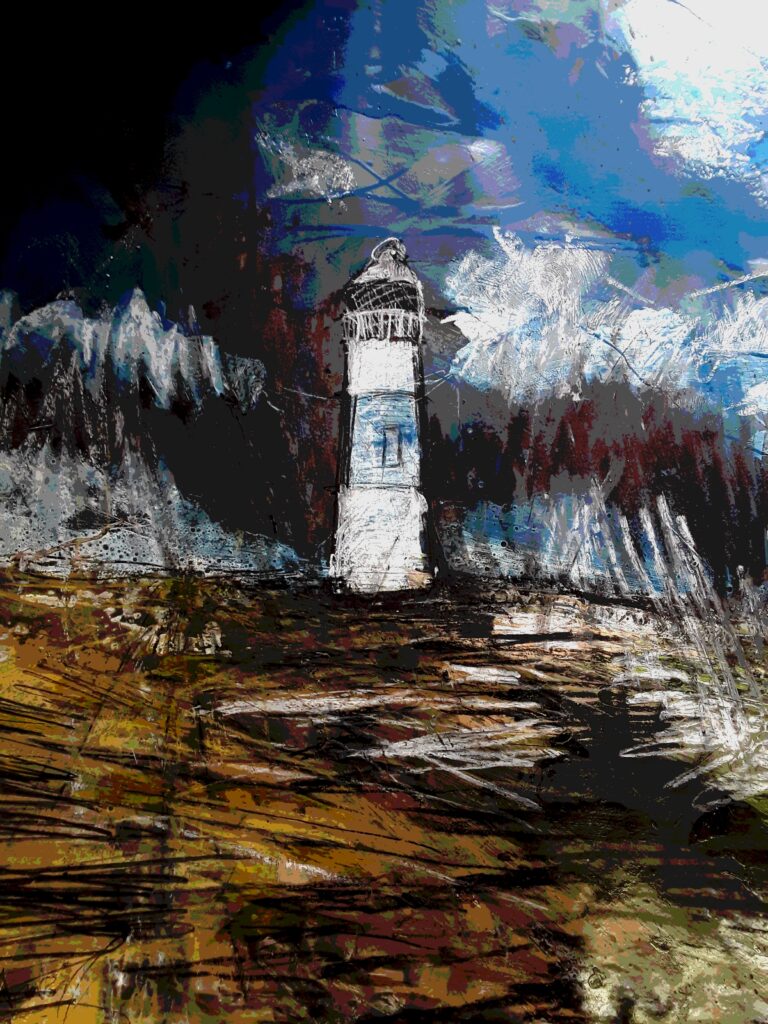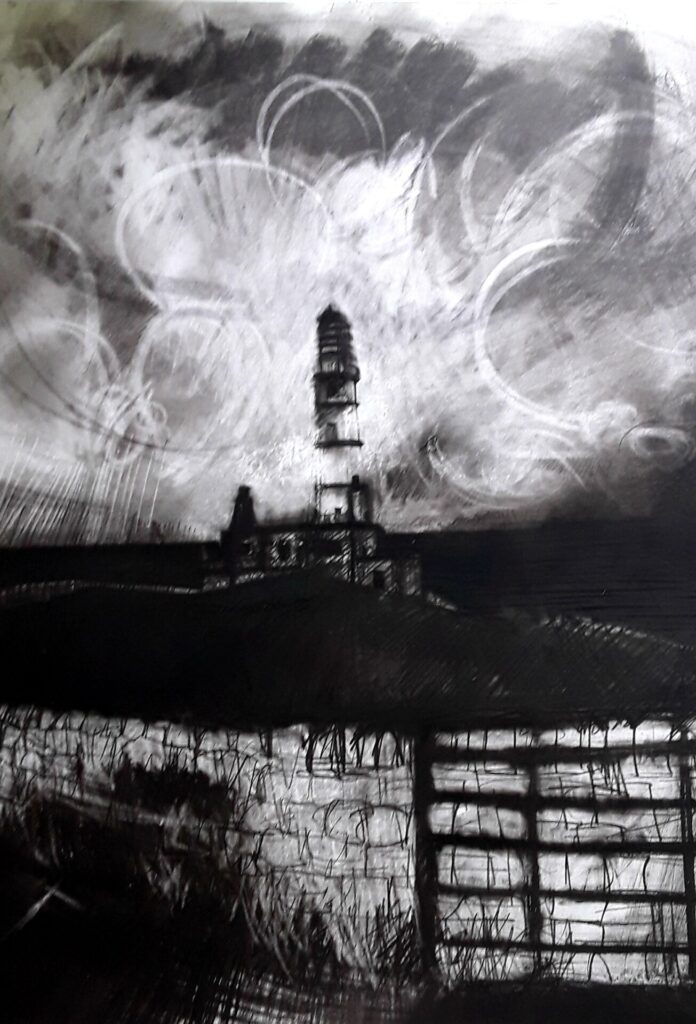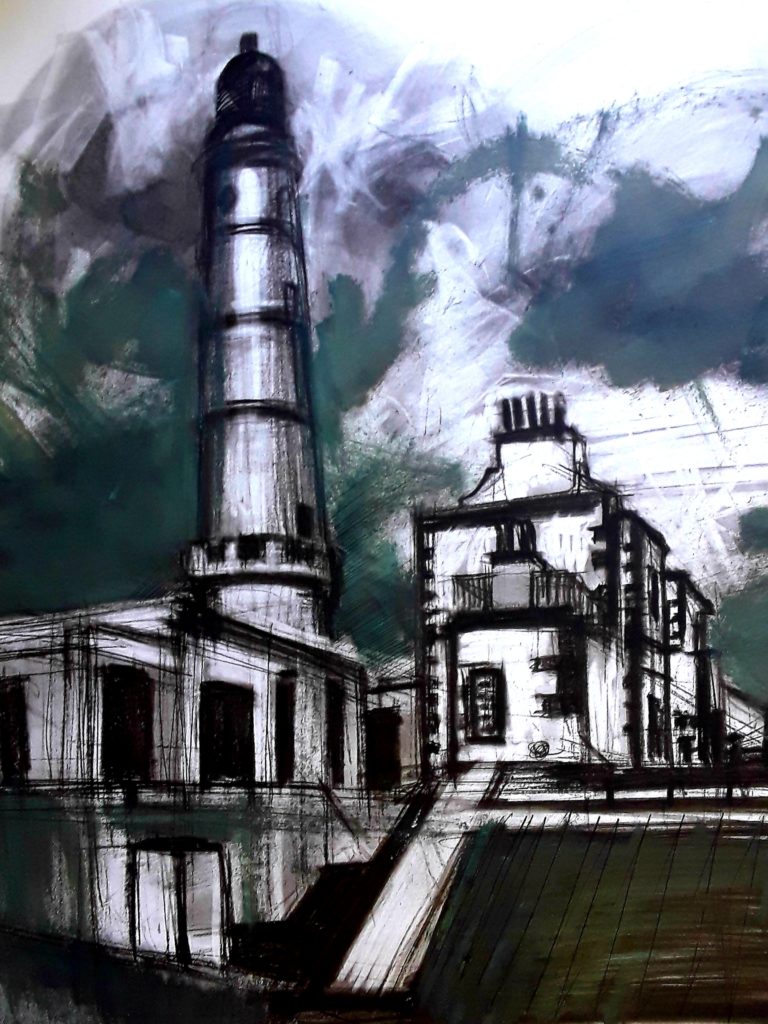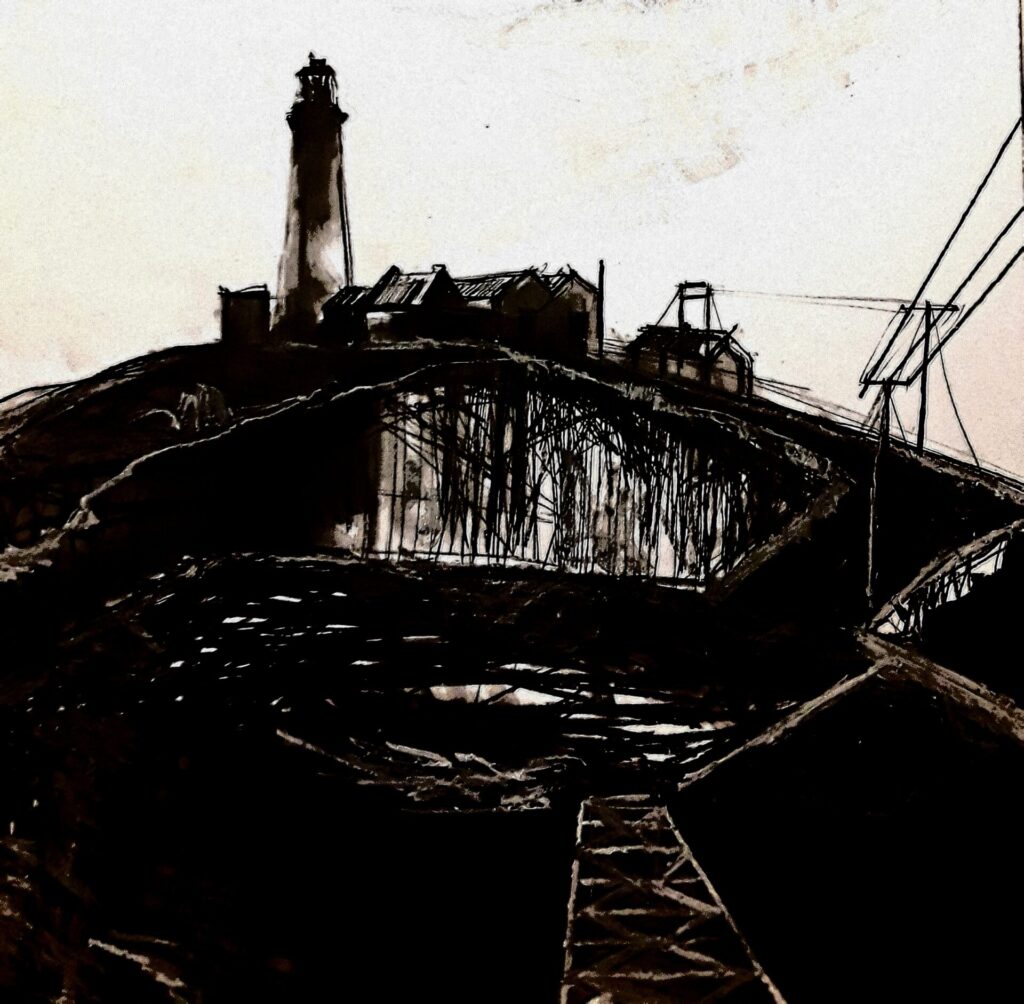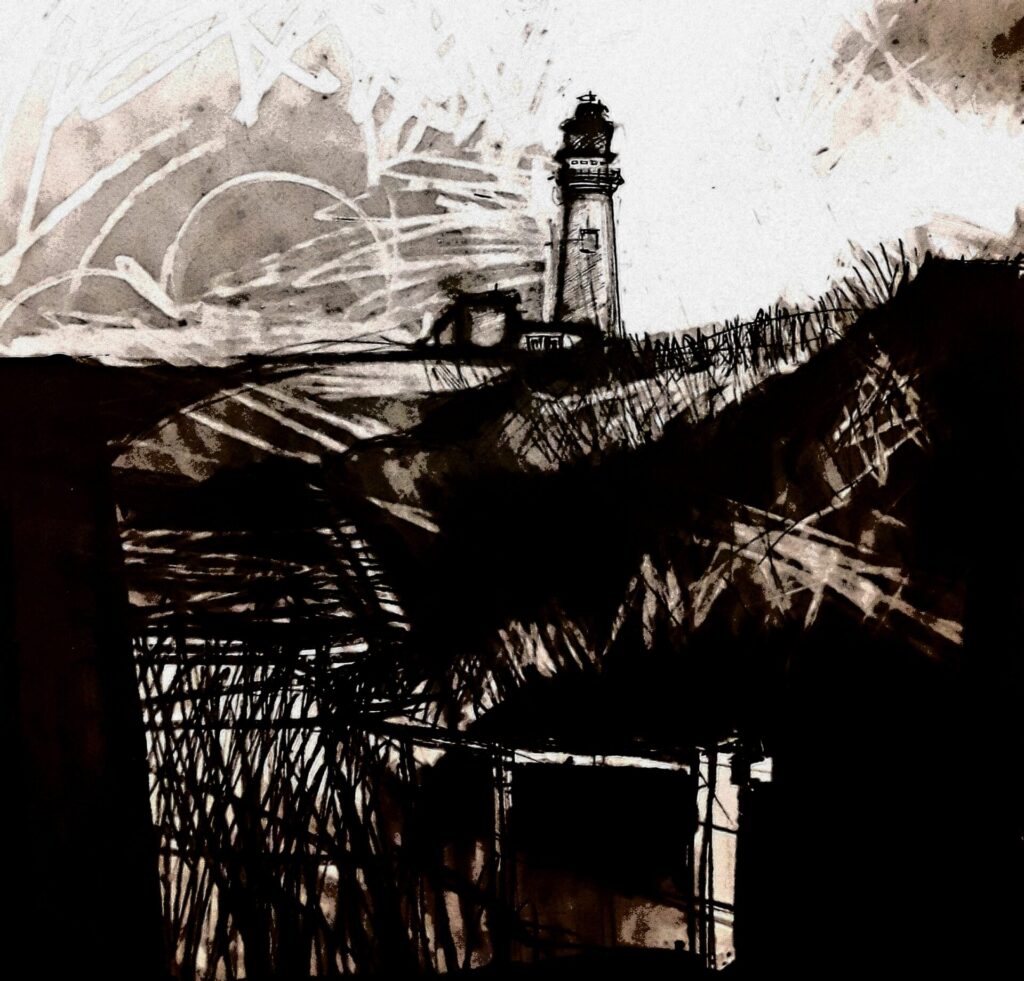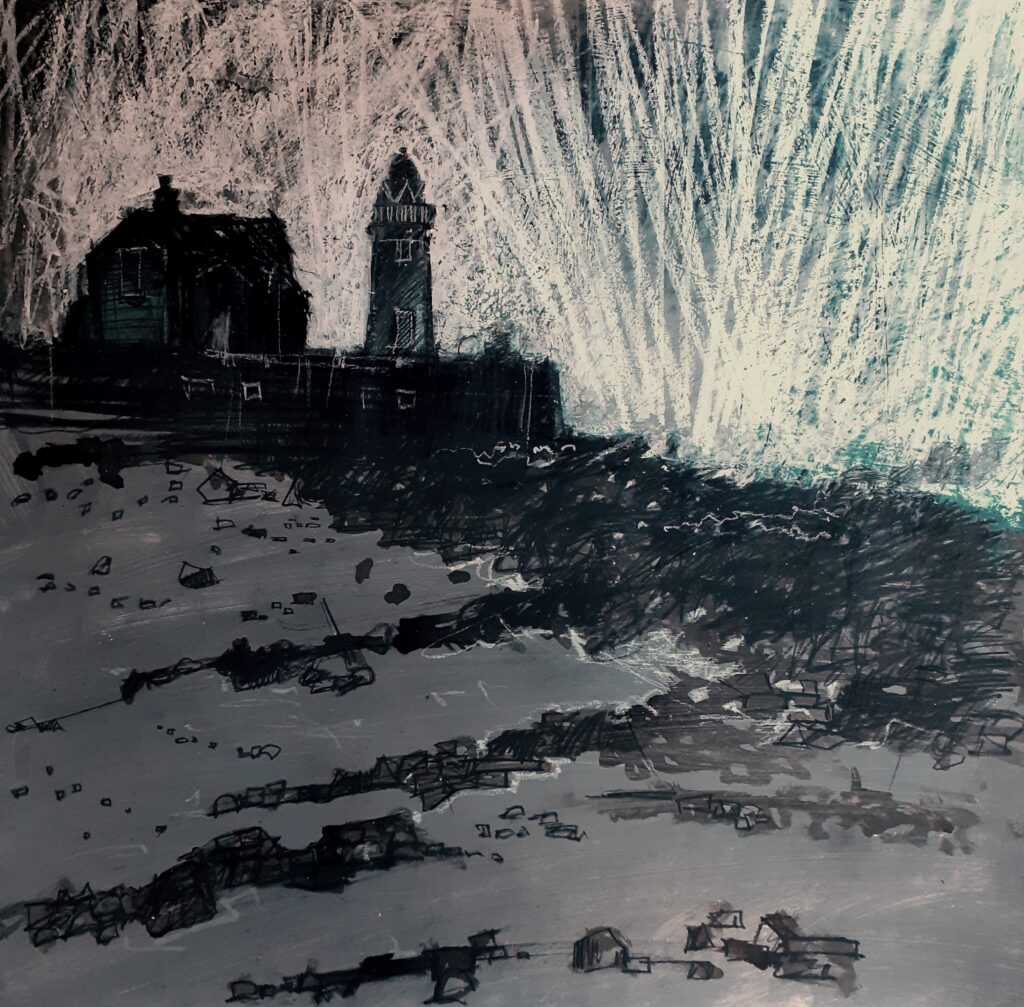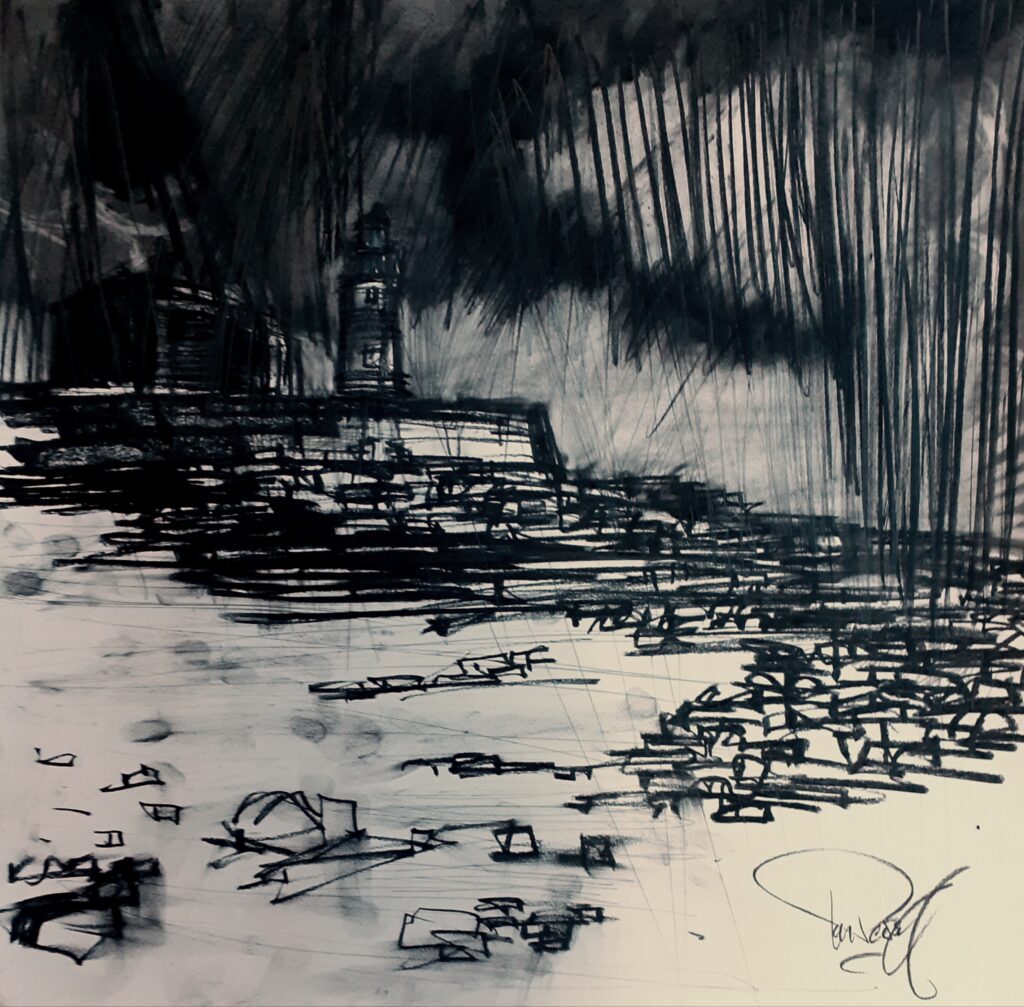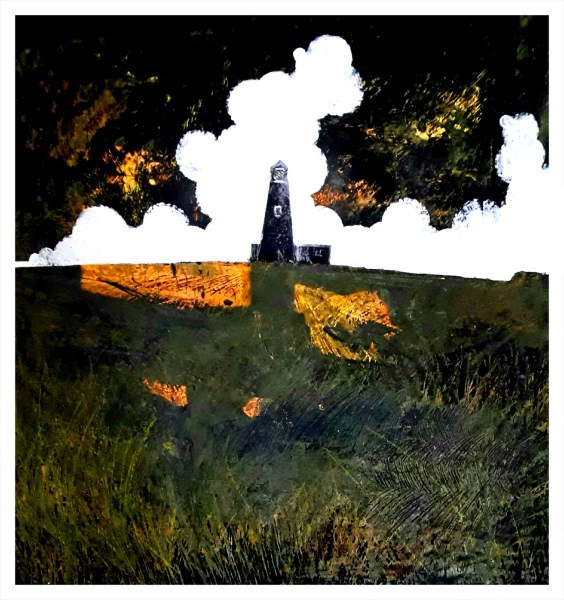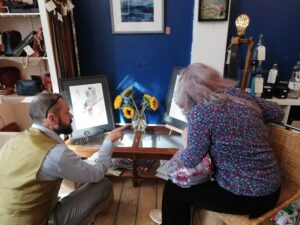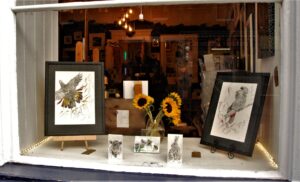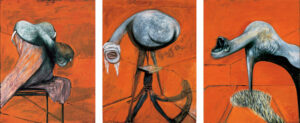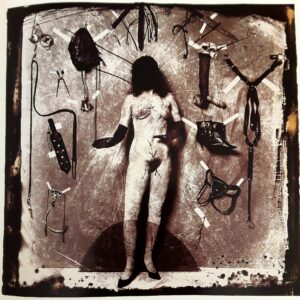“The show, “Witchfinder”, draws its inspiration from the Scottish Witch Trials, the Scottish
Witchcraft Act of 1563,” says the artist Megan Archibald, “and the tales of the men and women hung as witches that carry on through our culture today — in fact, very near where I grew up, there’s a roundabout reputedly named after a witch (Lizzie Brice), there’s the “witches graves” near Aberdeen, there’s the grim history of pleasant Princes Street Gardens’ past as the Nor Loch, the site of dunking the witches.”
“So it might be surprising that there isn’t a single literal depiction of a witch here. Not a
pointy hat or cat to be seen,” she continues. “I recall so clearly leaving the Aberdeen City Archives in a state of catatonia — it’s odd, to hold in your bare hands the death warrant of another human being, even if a few centuries separate you from them. It’s even odder to hold the bill, itemised and macabre, of
the cost of burning them. Seas of time separate you from them — your humanity ties you together.
And even grimmer to realise, they weren’t witches. Well, of course they weren’t witches. But
they weren’t the kitschy cute story we like to tell either — of healers, charmers and psychics. Yes,
sometimes their dittays accused them of making charms, of having familiars, of helping in
childbirth and curing diseases. Sometimes, they even really did these things — in a world before
modern medicine, or the ability to predict a tempest at sea, you could make a little money selling
red ribbons tied as charms to fishermen’s wives, or aiding the sick. But really — they were poor,
they were forgotten. They went against norms, using today’s language we might have said some
struggled with alcohol addiction, or had mental health problems. In amongst these fantastical ideas
of charms, healing and magic dogs called Vinegar Tom, there were accusations of drunken and
disorderly behaviour; pursuing the wrong lover; acting irrationally; jealousy; hatred; brawling with
a neighbour; fighting with a friend. Who reading this can put their hand on a Bible and tell me that
they’ve never gotten drunk and acted silly, never fallen for the wrong person and taken leave of
their senses, had a fight with their neighbour, or been jealous of another?”

Whilst there were exceptions to this, overwhelmingly those accused as witches came from
the underclass of society. And when this was the exception, there was always a political reason to
accuse the higher ranking person (I’m looking at you, King James, and your accusing a woman of
witchcraft and burning her at Edinburgh Castle because you…wanted her castle and her husband
was dead). Turning on the television today, tells me that often we still look to those who have least,
who have addictions, or even disability and mental health conditions, as the “problem”, as the
“plague on the good people”. As the threat.
It’s difficult, living in Scotland today with a pretty clear division between Church and State,
to fully visualise just how much of a shake up the Reformation gave to Scottish daily life. The first
Reformation Parliament, the one that passed the Witchcraft Act, was also dealing with not
insignificant concerns about marriage laws, property laws. Some have argued that the Witchcraft
Act was actually an anti-Catholic sentiment, snuck through under the nose of Mary Queen of Scots,
just to get another one-up on the Catholic Queen from her Protestant Parliament. When your
whole world, your whole culture, has just been shaken from the ground up, the laws are being re
written, the church you knew is gone, and martyrs have burned, Leith has been under Siege, and
marital law was declared in Perth — no wonder people were terrified, no wonder people began to
turn on each other. The atmosphere must have been incredibly tense, before we consider the
carnage that the years of fighting had wrought on the country. In times of tribulation and change, it
is easy to pick on the easiest victim; it is easy to sew moral panic; it is easy to blame another for our
misfortunes. It’s easy to draw parallels to Brexit, COVID-19, Scottish Independence…

My favourite piece here is Black No. 1. He’s named after the colour of ink he’s printed in. I
found the photograph I worked from as a reference for that woodcut in a junk store in Aberdeen,
not a stone’s throw from where the accused witches were held in their makeshift prison, before
their trials, in the spire of St Nicholas Kirk. The story apparently goes, that at sometime in the late
18th or early 19th century, a local photographer either didn’t get paid, or people didn’t come back
to collect their portraits. This box of unknown people, Aberdeen locals, photographed right there
on the street the accused witches were sentenced on, somehow made it through a century and to
me, and I promptly bought it. I know nothing about any of these people, not even their names —
but they served as a connection through the city’s past, staring out at me from the studio walls as I
read the dittays. Maybe he has nothing to do with it — maybe he has everything, the visual
reminder to myself that people have always been people; and that seas of time and cultural shifts
change the backdrops, but that the threads that tie us together stay.”
With my sincerest thanks to:
The Aberdeen City Archives, The Seven Incorporated Trades of Aberdeen, City of the
Dead Tours, Jamie Corstorphine, Leonard Low, Old Aberdeen Bookshop, and The
Church of Scotland Ministers and Reverends who so warmly invited me in, especially
the community in Aberdeen, Peacock Visual Arts + The Glasgow Print Studio.
And my friends, who somehow don’t hate me after a year of talking about John Knox
The exhibition runs until Saturday November 11.




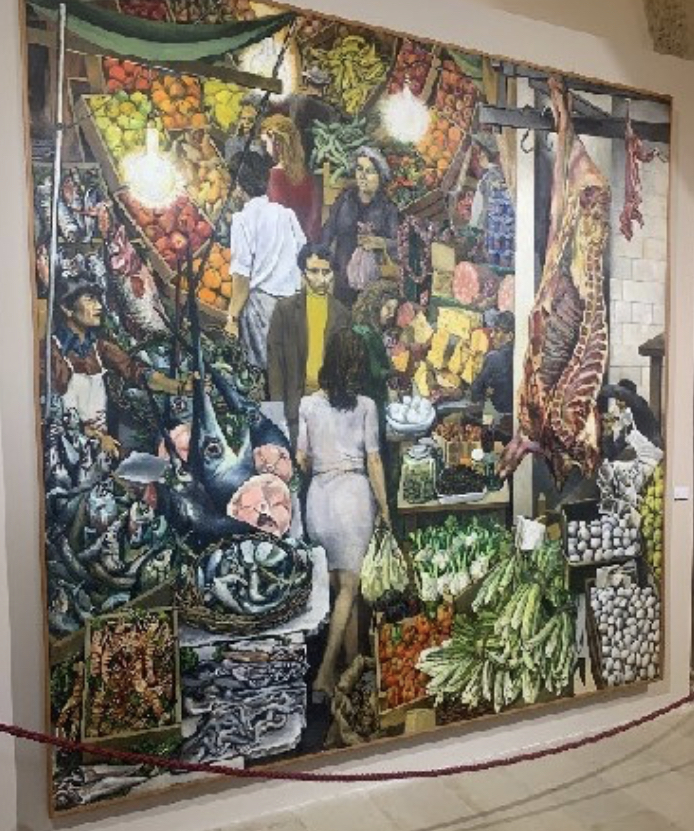





 Aged around 15, I bought a postcard of Munch’s ‘Madonna’ oil painting from an art gallery shop and still have it in my studio. My favourite version is this print, which completely blew me away. The limited palette and bold line work is powerful and more graphic. She’s not a weak, submissive Madonna, she is in control and has attitude! Best of all, this version has the curious red border with the ghoulish foetus lurking in the corner. I became quite obsessed with the foetus on my National Diploma course and ended up creating a sort of shrine/installation to it (which later ended up in a room in my rented flat) I even painted a foetus symbol on a fellow student’s garden wall as part of a mural!
Aged around 15, I bought a postcard of Munch’s ‘Madonna’ oil painting from an art gallery shop and still have it in my studio. My favourite version is this print, which completely blew me away. The limited palette and bold line work is powerful and more graphic. She’s not a weak, submissive Madonna, she is in control and has attitude! Best of all, this version has the curious red border with the ghoulish foetus lurking in the corner. I became quite obsessed with the foetus on my National Diploma course and ended up creating a sort of shrine/installation to it (which later ended up in a room in my rented flat) I even painted a foetus symbol on a fellow student’s garden wall as part of a mural!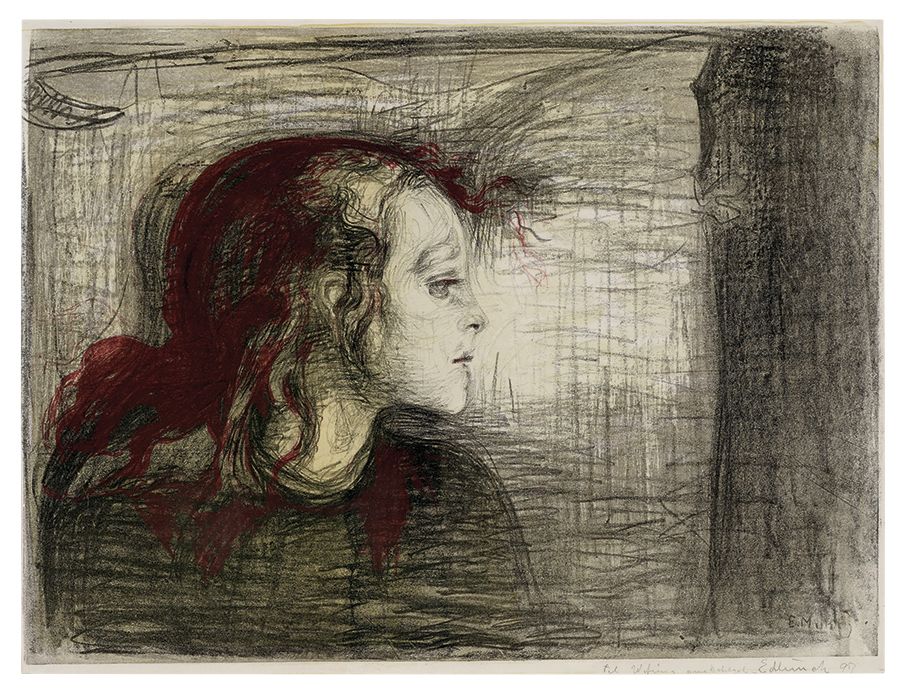

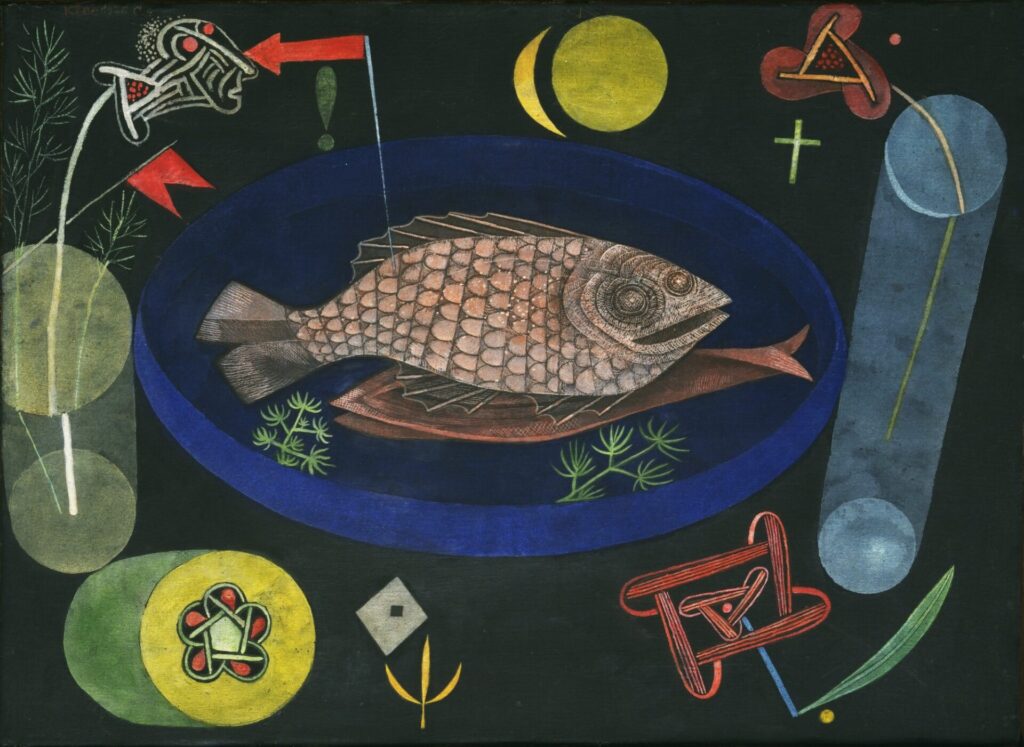 The bold hues of mostly primary colours, against the dark background in this oil painting are sublime. I am fascinated by the cosmic free-floating objects and symbols orbiting the fish which is either swimming in a pond or dead on a plate, I can’t really tell, but my interpretation is that it is in a inky pool of deep water and very much alive. To me, the symbols represent evolution and science, but also religion, time and the astral plane. It was painted soon after the Nazis rose to power in 1933 and Klee was suspended from his teaching position in the Bauhaus, where the work was described as “degenerate art” and derided as childlike, disorderly, and confused. These are the qualities that resonate with me and draw me into his work.
The bold hues of mostly primary colours, against the dark background in this oil painting are sublime. I am fascinated by the cosmic free-floating objects and symbols orbiting the fish which is either swimming in a pond or dead on a plate, I can’t really tell, but my interpretation is that it is in a inky pool of deep water and very much alive. To me, the symbols represent evolution and science, but also religion, time and the astral plane. It was painted soon after the Nazis rose to power in 1933 and Klee was suspended from his teaching position in the Bauhaus, where the work was described as “degenerate art” and derided as childlike, disorderly, and confused. These are the qualities that resonate with me and draw me into his work.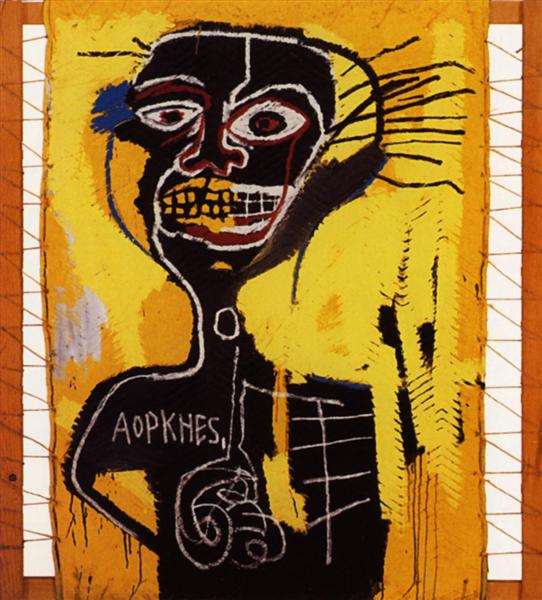 Basquiat was incredibly successful at distilling all the elements that make him who he is into his paintings – his ancestry and cultural history, the 1980s New York art and music scene, graffiti, his first hand experience of racism and police brutality towards young black men, his vast knowledge of the body learned from intently studying Grays Anatomy as a child (when he was in hospital after being hit by a car), a deep understanding of symbols, consumerism and the constant stream of background noise from cartoons, TV shows and adverts, all channeled into something very personal and unique.
Basquiat was incredibly successful at distilling all the elements that make him who he is into his paintings – his ancestry and cultural history, the 1980s New York art and music scene, graffiti, his first hand experience of racism and police brutality towards young black men, his vast knowledge of the body learned from intently studying Grays Anatomy as a child (when he was in hospital after being hit by a car), a deep understanding of symbols, consumerism and the constant stream of background noise from cartoons, TV shows and adverts, all channeled into something very personal and unique. Pre-Nazca pottery and Paracas textiles from Peru really appeal to me and I’ve spent time in museums observing and sketching them. I particularly love the patterns and colours. Indigenous people, plants, animals and birds are simplified into decorative patterns and stylised to flow around and fit into shapes. Some of the symbols remind me of creatures on Pictish Symbol Stones from north east Scotland. They have so much personality.
Pre-Nazca pottery and Paracas textiles from Peru really appeal to me and I’ve spent time in museums observing and sketching them. I particularly love the patterns and colours. Indigenous people, plants, animals and birds are simplified into decorative patterns and stylised to flow around and fit into shapes. Some of the symbols remind me of creatures on Pictish Symbol Stones from north east Scotland. They have so much personality.
